 [This
is a draft of the first of several new chapters that I am writing for the second
edition of my book. I hope to publish the second edition in late 2001.]
[This
is a draft of the first of several new chapters that I am writing for the second
edition of my book. I hope to publish the second edition in late 2001.] [This
is a draft of the first of several new chapters that I am writing for the second
edition of my book. I hope to publish the second edition in late 2001.]
[This
is a draft of the first of several new chapters that I am writing for the second
edition of my book. I hope to publish the second edition in late 2001.]
Have you ever wondered which dance to do to a particular song? While there are no rules dictating which dance to choose—that is entirely up to you and your partner, so long as you are considerate of your neighbors on the dance floor—the following chapter may help you pick a dance that lets you comfortably express yourself to the music being played.
Dancing is more fun when the dance naturally fits the music. Some people will apply the same dance to every song that comes along, regardless of rhythm or tempo, but this just validates the adage that when you have a hammer, everything looks like a nail. Knowing a wide variety of dances and how they relate to the music will enhance your self-expression through dance.
A social dancer's music appreciation passes though several stages.
The best way to determine which dance fits a particular song is to experiment. This chapter will get you started by suggesting one or more candidates for each type of music that you're likely to hear at a dance.
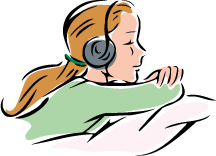 Typical
Dance Songs
Typical
Dance SongsIf you are a new dancer, your first step toward dance-music awareness is to listen to songs that have been identified by dance. The brief table below lists one song for each of 18 partner dances; many more examples are given in the extensive song summary table at the end of the chapter. Clicking a song title should play a 30-60 second RealAudio sound clip. If you have difficulty playing the songs, see the technical note on playing audio files.
Song tempi are listed in measures per minute (MPM). As discussed in greater detail in Chapter 5–Collecting Dance Music, an easy (though not especially accurate) way to count MPM is to tap out the number of beats in a particular interval—20 seconds for music in 3:4 time (Waltzes), 30 seconds for music in 2:4 time (Sambas), or 15 seconds for music in 4:4 time (all other dances discussed here).
| Dance | Song |
| Waltz (slow) | Take It To The Limit [Eagles; 30 MPM] |
| Viennese Waltz | Caribbean Blue [Enya; 53 MPM] |
| Foxtrot | Why Don't You Do Right [Sinead O'Connor; 29 MPM] |
| Tango (marching) | La Cumparsita/Tango Please (Medley) [David Hirschfelder & The Bogo Pogo Orchestra; 34 MPM] |
| Quickstep | Billy-A-Dick [Bette Midler; 53 MPM] |
| Cha Cha | Smooth [Santana; 29 MPM] |
| Rumba | Cuando Me Querias Tu [Linda Ronstadt; 29 MPM] |
| Bolero | Why [Annie Lennox; 23 MPM] |
| Mambo/Salsa | Dia Y Noche Pienso En Ella [Jerry Rivera; 48 MPM] |
| Samba | Ma Fiancee Elle Est Partie [Dany Brillant; 48 MPM] |
| East Coast Swing/Jive | Bloodshot Eyes [Pat Benatar; 46 MPM] |
| West Coast Swing | You're The Boss [Brian Setzer Orchestra; 32 MPM] |
| Lindy Hop | Are You Hep To The Jive [Big Time Operator; 38 MPM] |
| Balboa | Pop's At The Hop [Indigo Swing; 61 MPM] |
| Shag | At The Swing Cat's Ball [Louis Jordan; 58 MPM] |
| Argentine Tango | |
| Hustle | Don't Stop 'Til You Get Enough [Michael Jackson; 30 MPM] |
| Nightclub Two Step | Take A Bow [Madonna; 20 MPM] |
A good way to pick a dance that suits a given song is to consider the song's rhythm, tempo, and character.

Rhythm is the structure of the music, and it is what makes the sound of Cha Cha music {Smooth [Santana; 29 MPM]} very different from that of Foxtrot music {Why Don't You Do Right [Sinead O'Connor; 29 MPM]}, even though both are played in 4:4 time at about 30 MPM. Each dance also has a rhythm pattern, which may or may not match the rhythm of the music to which it is danced. For example, the Cha Cha basic is danced 2 3 4 & 1 (a.k.a. 2 3 cha-cha-cha), where the triple step 4 & 1 coincides with the cha-cha-cha sound heard in traditionally-structured Cha Cha music {Evil Ways [Santana; 29 MPM]}. However, the Hustle basic is danced in 3 beats (& 1 2 3) to music with 4-beat measures {Don't Stop 'Til You Get Enough [Michael Jackson; 30 MPM]}, which has been known to annoy musicians who dance.
The rhythms of dance music have been detailed elsewhere on the Internet (e.g., the Rec.Arts.Dance FAQ; "The Complete Book on Disco and Ballroom Dancing" by Angelo Algoso; and the monthly newsletter of Ron & Rebecca Kellen). In this chapter, dance-music rhythms will be demonstrated with audio samples.
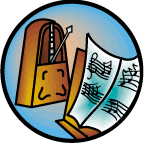 Tempo
TempoSince it can be awkward to dance too slowly or too quickly, song tempo plays an important role in determining whether a dance is comfortable to perform to a given song. The speed at which one dances depends on the tempo of the music (measures/minute), the pace of the dance (steps/measure), the length of each step, and the degree of rise and fall. While it's easy to adjust step length, a dance's pace and rise & fall are largely fixed. Hence, it is helpful to pick a dance whose pace and extent of rise & fall make it comfortable to perform at the tempo of the music being played. The table of dance speeds shows the basic pattern and pace for various dances.
The suitable song tempo for each dance is a somewhat controversial subject. Some dancers (particularly competitors) tolerate only an extremely narrow range of tempi for each dance (e.g., dancing International Rumba only to songs at 26 MPM). Others dancers are happy at any speed, such as those who will dance West Coast Swing to relatively fast music (e.g., songs at 35+ MPM). Over the years, I've developed a two-part philosophy on music tempi suitable for social dances.
 Character
CharacterThe character of a song inspires the motion and attitude used to dance to the music. A song may make you want to
It may be
Picking a dance that suits the character of the song will make your dancing more expressive.
Your dance options are enhanced (or perhaps complicated) by the fact that there may be more than one dance performed to the same type of music. You may have to choose between the American and the International styles of a dance, between a swing dance and a non-swing dance, between a Cha Cha and a Hustle, etc. Here is an overview of dances related by music, or "dance families."
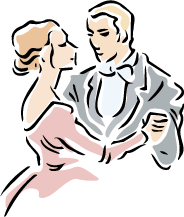 Waltz
WaltzBallroom versions of Waltz include Slow Waltz (a.k.a. Waltz) and Viennese Waltz. Both are danced to triple-time music (3 beats/measure), but Slow Waltz is danced at 27-33 MPM {Love Has No Pride [Linda Ronstadt; 28 MPM]}, about half the speed of Viennese Waltz (54-60 MPM) {Vienna Life [Lawrence Welk; 60 MPM]}.
There are American and International styles of each dance. International-style dancers may prefer 28-29 MPM for Slow Waltz. If dancing Viennese Waltz to music around 60 MPM {The Carousel Waltz [1994 Broadway Cast Recording; 62 MPM]}, you may find it easier to dance the closed-position figures present in both International and American styles than the open-position figures found only in the American style.
Some excellent Waltz songs {Kiss From A Rose [Seal; 45 MPM])} are too fast for slow Waltz and too slow for Viennese Waltz. I have not yet found a happy solution to this problem, but one of the non-ballroom varieties of Waltz might work. If you find a winner, let me know.
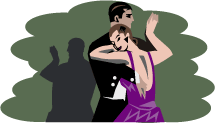 Tango
TangoThere are three styles of Tango: American Tango, International Tango, and Argentine Tango. American and International Tango are staccato dances usually performed to orchestral Tangos, 30-34 MPM, played with a strong marching rhythm {La Passionara [VA-Latin Passion; 31 MPM]}. Hence, I think of them as marching tangos. Argentine Tango may be alternately sharp or fluid, and is typically danced to authentic Tangos that are more sophisticated and less regular in tempo {El Choclo [Forever Tango soundtrack; 32 MPM]}.
If you hear a strong and regular march in the music, try American or International Tango. In competition, American Tango is danced at 30-32 MPM {El Toreador [VA-Latin Passion; 31 MPM]}, and International Tango at 32-34 MPM {La Cumparsita/Tango Please (Medley) [David Hirschfelder & The Bogo Pogo Orchestra; 34 MPM]}, but this is not particularly relevant to social dancing. If the song is playful, try Argentine Tango instead.
I've heard it said that the three styles of Tango are like stages of a romance. American Tango, polite and romantic, is the courtship; Argentine Tango, fiery and passionate, is the honeymoon; and International Tango—well, that's when you're staying together for the sake of the kids :-). Recently, I have noticed a happy trend in which International-style dancers have begun to use authentic Tango music (i.e., songs to which one would ordinarily dance Argentine Tango) for shows.
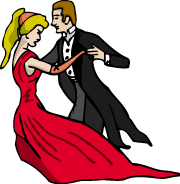 Foxtrot,
Quickstep, East Coast Swing, West Coast Swing, Lindy Hop, Shag, Balboa
Foxtrot,
Quickstep, East Coast Swing, West Coast Swing, Lindy Hop, Shag, BalboaThere is a large family of dances performed to swing music and blues music, including (but not limited to) Foxtrot, Quickstep, East Coast Swing, Jive, West Coast Swing, Lindy Hop, Shag, and Balboa.
Foxtrot is great for swing songs that make you want to travel down the floor. Foxtrot is danced at 27-33 MPM, and may be performed in the American style—open and theatrical, à la Fred Astaire & Ginger Rogers—or in the International style, which is closed and subtle. International style dancers may prefer songs around 28-29 MPM {Can't We Be Friends [Ella Fitzgerald/Louis Armstrong; 28 MPM]}, while American style dancers may enjoy peppier music {Let's Get Away From It All [Frank Sinatra; 30 MPM]}. The theatrical nature of American Foxtrot excellently expresses dramatic songs {Why Don't You Do Right [Sinead O'Connor; 29 MPM]}.
Quickstep is an International-style only dance performed to swing and Dixieland music at 47-55 MPM, with songs near 52 MPM {Down The Alley (With You) [A River Runs Through It soundtrack; 52 MPM]} preferred by competitors. Like Foxtrot, Quickstep is a traveling dance suited to songs that propel you down the dance floor {Four Brothers [Manhattan Transfer; 52 MPM]; Billy-A-Dick [Bette Midler; 53 MPM]}.
 East
Coast Swing/Jive
East
Coast Swing/JiveEast Coast Swing and its International-style sister, Jive, are good for medium-tempo swing music (36-46 MPM) with a strong backbeat and an insistent bounce {Bad, Bad Leroy Brown [Jim Croce; 37 MPM]; Trickle Trickle [Manhattan Transfer; 46 MPM]; Bloodshot Eyes [Pat Benatar; 46 MPM]}. These are bouncy dances for bouncy songs that keep you moving at a steady clip {Hanky Panky [Madonna; 43 MPM]}. Since East Coast Swing and Jive use predominantly 6-beat figures—that is, most patterns are danced in 6, rather than 8, beats—figures are only occasionally aligned with the music. In other words, most figures will not begin on count 1 of the music.
West Coast Swing is a dance of 6 and 8 beat figures that's ideal for slow, bounceless music (typically blues) at speeds of about 27-33 MPM {She Makes Me Feel Good [Lyle Lovett; 31 MPM]}. This grounded dance can be used to express dramatic {When The Lights Go Out [Jimmy Witherspoon; 25 MPM]}, sexy {You're The Boss [Brian Setzer Orchestra; 32 MPM]}, or funky {Mama Told Me (Not To Come) [Three Dog Night; 30 MPM]} songs. It's particularly good for songs with breaks, and its eight-beat figures can be aligned with the music. The follower also has more freedom to improvise in West Coast Swing than she does in East Coast Swing.
Some West Coast Swing dancers will apply this dance to disco or hip hop music.
 Lindy
Hop
Lindy
HopEast Coast Swing and West Coast Swing both descend from Lindy Hop, a versatile dance of 6 and 8 beat figures that can be applied to slow {Comes Love [Johnny Nocturne Orchestra w/Kim Nalley; 29 MPM]}, medium {Saturday Night Fish Fry [Louis Jordan; 44 MPM]}, or fast {Leap Frog [Big Time Operator; 49 MPM]} swing and jump blues music. Lindy Hop is often danced to bouncy songs {Are You Hep To The Jive [Big Time Operator; 38 MPM]} with weak backbeats. Lindy Hop is similar to West Coast Swing with regard to breaks, musical alignment, and follower improvisation.
There are several styles and variants of Lindy Hop. Savoy (a.k.a. New York) style Lindy Hop is danced low and bouncy, while the Hollywood and Dean Collins styles are danced tall and level. The latter two styles, along with another variant, Speed Lindy, can be applied to very fast music {Camp Hollywood Special [Bill Elliott Swing Orchestra; 58 MPM]}.
Lindy Hop is sometimes danced with hip hop styling to hip hop music.
Shag dances include Collegiate Shag (a.k.a. Arthur Murray Shag), St. Louis Shag, and Carolina Shag. Collegiate Shag's small 6-count figures are well-suited to fast swing music {At The Swing Cat's Ball [Louis Jordan; 58 MPM]}. The basic is danced on the balls of the feet; this, combined with the lack of a "rock step" in the basic, makes the dancers appear to hover in the air. It's an energetic but compact dance that lets you cope with music too fast for East Coast Swing/Jive or Lindy Hop.
St. Louis Shag consists mostly of 8-count figures danced side by side to fast music {Saturday Night Fish Fry (faster) [Louis Jordan; 54 MPM]}. [To be expanded.]
I have no experience with Carolina Shag.
Balboa is a very compact dance of small, level steps that can be comfortably performed to very fast swing music {At The Swing Cat's Ball [Louis Jordan; 58 MPM]}, especially songs that make you want to shuffle back and forth {Pop's At The Hop [Indigo Swing; 61 MPM]}. Its compact figures take little energy, and, like Collegiate Shag or St. Louis Shag, Balboa is an excellent choice when the music is too fast for East Coast Swing or Lindy Hop.
 Picking
A Dance For Swing or Blues Music
Picking
A Dance For Swing or Blues MusicSlow songs are generally danced as Foxtrot, Lindy Hop, or West Coast Swing, depending on the song's character. If it travels {Why Don't You Do Right [Sinead O'Connor; 29 MPM]}, try Foxtrot; if it's bouncy {Comes Love [Johnny Nocturne Orchestra w/Kim Nalley; 29 MPM]}, try Lindy Hop; if it's level and earthy—and especially if it's bluesy—try West Coast Swing {Smack Dab In The Middle [Buster Poindexter; 32 MPM]}. Some songs have complex characters that can be expressed through more that one dance. A grounded song that travels {This Business Of Love [Domino; 30 MPM]} can be danced as West Coast Swing or Foxtrot; a bouncy song that travels {I'm Beginning To See The Light [Natalie Cole; 30 MPM]} could be either Foxtrot or Lindy Hop.
Medium-tempo songs are usually danced as East Coast Swing/Jive or Lindy Hop. If the song has a strong backbeat and an insistent rhythm {Big Fun [Barry Manilow; 39 MPM]}, it may be a good candidate for East Coast Swing/Jive. If the backbeat is more subdued {Reet, Petite, And Gone [Indigo Swing; 41 MPM]}, Lindy Hop may be your best bet.
Fast songs are typically danced as Quickstep, Shag, Balboa, or Lindy Hop. It's useful to consider both the character of the music, and the speed at which you must dance. If the song inspires you to travel {Sing, Sing, Sing (With A Swing) [Benny Goodman; 55 MPM]}, try Quickstep; if it induces you to shuffle, try Balboa {Pop's At The Hop [Indigo Swing; 61 MPM]}; otherwise, it might be a candidate for Shag or Lindy Hop.
When the music is fast, consider the effort required by each dance, which depends on pace, stride, and rise and fall. In descending order, the paces of dances done to medium and fast songs are Triple-Step East Coast Swing/Jive, 5 1/3 steps/measure; Lindy Hop, 5; Collegiate Shag and Balboa, 3; Quickstep, 2 2/3; and Speed Lindy, 2. Thus, a song at 50 MPM will require 250 steps/minute as a regular Lindy Hop, 150 steps/minute as a Balboa, or 100 steps/minute as a Speed Lindy.
Stride length is also important. Quickstep has a slow pace but a long stride, which make its strenuous to apply to music above 55 MPM. Lindy Hop can be made more applicable to fast music by taking tiny steps, but its basic figures (e.g., a swingout) generally entail a fair bit of movement to change places with your partner, even in a slow-paced variant like Speed Lindy. Balboa and Collegiate Shag are compact and can be danced with small steps.
Rise and fall add vertical motion to the dance. Quickstep progressively rises over the course of each basic figure, with a fall at the start of the following figure. The basics of Triple Step East Coast Swing/Jive and Savoy-style Lindy Hop bounce up and down, while the basics of Hollywood-style Lindy Hop, Dean Collins-style Lindy Hop, and Balboa are relatively level. Collegiate Shag is generally danced level, but high on the balls of the feet; staying up there can be an aerobic experience!
The upshot: if you like dancing vigorous dances (e.g., Lindy Hop, Triple Step East Coast Swing/Jive) to fast music, enjoy. However, you have alternatives (Quickstep, Balboa, Shag, Speed Lindy) that require less effort and thus may be more comfortable to dance to high-speed songs.
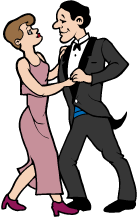 Bolero,
Rumba, Mambo, Salsa, and Cha Cha
Bolero,
Rumba, Mambo, Salsa, and Cha ChaBolero, Rumba, Mambo, Salsa, and Cha Cha are a family of dances traditionally performed to Afro-Cuban music, though now danced to a wider range of songs. Bolero and Rumba are danced to slow music; Cha Cha is danced to medium tempo music with a cha-cha-cha rhythm; and Mambo and Salsa are danced to fast music, about twice the speed of that used for Bolero and Rumba.
Bolero, International Rumba, and American Rumba are closely-related slow Latin dances traditionally performed to a style of Afro-Cuban music called Bolero {Beautiful Maria Of My Soul [Mambo Kings Soundtrack; 23 MPM]}. (The ballroom dance Rumba is poorly named, because the style of Afro-Cuban music named "Rumba" is quite fast {still looking for a good example with RealAudio file on CDNow.com—any suggestions?}.) Today, these dances are also performed to non-Latin popular music in 4:4 time {Wicked Game [Chris Isaak; 28 MPM]}. Tempos range from about 22-30 MPM.
All three dances have the same pace (3 steps/measure), but have varying lengths of stride and degrees of rise and fall. Bolero (the dance) has a swooping rise and fall and a long stride, which suits it to relatively slow music in the range of 22-24 MPM {Jesus To A Child [George Michael; 22 MPM]; Mas Alla [Gloria Estefan; 23 MPM]}. International Rumba has less rise and fall and a shorter stride, and is usually danced to music in the range of 25-27 MPM {Happy Ever After [Julia Fordham; 25 MPM]; Perhaps Perhaps Perhaps [Doris Day; 26 MPM]}. American Rumba is often danced to music faster than that used for International Rumba (exactly why?) {Wicked Game [Chris Isaak; 28 MPM]; Cuando Me Querias Tu [Linda Ronstadt; 29 MPM]}.
Each dance can be adapted (within reason) to songs outside of its normal tempo range by modifying the extent of rise and fall or the length of stride. For example, International Rumba can be danced at Bolero speeds (22-24 MPM) by adding rise and fall and taking long steps, or at American Rumba speeds by dancing compactly. However, there are limits: it would be uncomfortable to dance Bolero at 30 MPM, or American Rumba at 22 MPM.
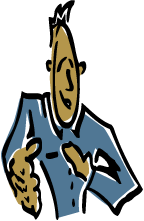 Mambo
and Salsa
Mambo
and SalsaMambo and Salsa (if they are to be considered distinct dances, which is a subject of much debate) are closely-related dances performed to fast Latin music (43-51 MPM) {Ran Kan Kan [Tito Puente; 51 MPM]; Dia Y Noche Pienso En Ella [Jerry Rivera; 48 MPM]}.
Mambo (as codified as an American-style competitive dance) looks much like Rumba at approximately double speed; its style is upright, sharp, and angular. Salsa comes in many flavors—perhaps as many as one per Latin American country—but typically has a more relaxed posture and is danced with more curves. The issue of salsa vs. mambo is addressed in Chapter 2—Learning To Dance. Briefly, my take on this matter (and it's just one in a sea of opinions) is that Salsa is a superset of Mambo, its 1950s predecessor.
Modern Salsa music {Una Aventura [Grupo Niche; 47 MPM]} may sound somewhat different than 1950s Mambo music {Dejame Sonar [Tito Puente; 50 MPM]}, but there is no particular reason to dance Mambo only to 1950s Mambo music, or Salsa only to modern Salsa music.
Cha Cha (a.k.a. Cha Cha Cha) is a variant of Mambo traditionally danced to medium tempo Latin songs (28-34 MPM) that have a cha-cha-cha rhythm {Cuban Pete [Mambo Kings soundtrack; 29 MPM]}. Cha Cha replaces Mambo's slow step with a triple step in time with the cha-cha-cha. That is, Mambo's quick quick slow rhythm (2 3 [4 1]) becomes quick quick quick & quick (2 3 4 & 1, or 2 3 cha-cha-cha) in Cha Cha.
Cha Cha may be danced to a wide variety of musical styles, including traditional Latin jazz {Oye Coma Va [Tito Puente; 34 MPM]}, modern pop {Me, Myself and I [Vitamin C; 29 MPM]}, jazz-funk {Cantaloop (Flip Fantasia) [US3; 29 MPM]}, techno {Magic Carpet Ride [Mighty Dub Katz; 33 MPM]}, and Latin pop {Smooth [Santana; 29 MPM]}, so long as the song includes a cha-cha-cha rhythm.
While International-style Cha Cha includes a few figures not found in American-style Cha Cha (e.g., the hockey stick), either style may be applied equally well to a given song.
If the music has a fast and muted cha-cha-cha rhythm {Early In The Mornin' [Louis Jordan; 34 MPM]}, it may be easiest to ignore the cha-cha-cha and dance the song as a Mambo with lots of time for hip action.
American-style Samba and International-style Samba are Waltz-like ballroom interpretations of the Afro-Brazilian Samba dance. Ballroom Sambas are performed to fast music (47-56 MPM) in Samba rhythm ("boom-chicka-boom") and time (2:4) {Ma Fiancee Elle Est Partie [Dany Brillant; 48 MPM]}, but the music may sound very different from that heard at Carnaval {example?}. In fact, it's unlikely that any of the songs to which you will dance ballroom Samba {Moliendo Cafe [Azucar Moreno; 49 MPM]; Maria [Ricky Martin; 51 MPM]; Tequila/Sinful Samba (Medley) [David Hirschfelder & The Bogo Pogo Orchestra Hirschfelder/Rio; 56 MPM]} will be Brazilian in origin.
There is little difference, if any, between the American and International styles of Samba.
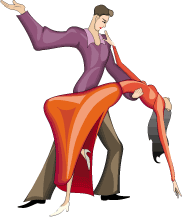 Hustle
HustleHustle is danced to disco music {Don't Stop 'Til You Get Enough [Michael Jackson; 30 MPM]; Good Times [Chic; 28 MPM]} and to more recent pop music {Vibeology [Paula Abdul; 30 MPM]; Emotions [Mariah Carey; 29 MPM]} at tempi of about 28-33 MPM. It is a rotating partner dance suited to "whirling" songs with a strong beat {You Should Be Dancing [Bee Gees; 31 MPM]; September [Earth, Wind & Fire; 32 MPM]}, and is essentially unrelated to the line dance of the same name.
As a 3-count dance (& 1 2 3) performed to music in 4:4 time, figures are only occasionally aligned with the music. There is a 4-count version of Hustle that does align with the music.
Songs that have a strong beat, a whirling character, and a cha-cha-cha triple on counts 4 & 1 can be interpreted either as Hustle or Cha Cha {Vogue [Madonna; 29 MPM]; Oye Como Va/Guajira [Azucar Moreno; 32 MPM]}. You can base your choice of dance on the relative strengths of the song's whirl and cha-cha-cha.
Nightclub Two Step (NC2S) is a dance performed to music in 4:4 time at tempi of about 17-21 MPM {The Lady In Red [Chris Deburgh; 19 MPM]}. It's easy to dance NC2S to such slow music because its 3-step basic figure is danced in only 2 beats (1 & 2, or 3 & 4). This makes NC2S faster than, say, Rumba, which is danced to faster music but takes 4 beats for its 3-step basic figure. (For example, a NC2S danced to music at 19 MPM has 114 steps/minute, while a Rumba danced to music at 26 MPM has only 78 steps/minute.)
Dancing NC2S is like skating on the dance floor. Typical NC2S songs have both a strong backbeat to define the third step of the basic figure {The Girl Is Mine [Michael Jackson/Paul McCartney; 21 MPM]}, and an airy melody that encourages a level glide on the balls of your feet {The Hounds Of Winter [Sting; 20 MPM]; Take A Bow [Madonna; 20 MPM]}. Some faster-than-usual songs can work well for NC2S if the melody is right {Reminiscing [Little River Band; 24 MPM]}.
 Dance
Speeds
Dance
SpeedsThe following table derives the pace of each dance (steps/measure) from the rhythm of its basic figure, and shows the number of steps per minutes required at a song tempo typical for that dance. The number of steps per minute, the length of each step, and the extent of rise and fall combine to determine the overall speed of the dance.
| Dance | Beats/Measure | Basic Rhythm | Steps/Basic | Beats/Basic | Pace (Steps/Measure) | Tempo (Measures/Minute) | Steps/Minute | Notes |
| Waltz (slow) | 3 | 1 2 3 | 3 | 3 | 3 | 29 | 58 | |
| Viennese Waltz | 3 | 1 2 3 | 3 | 3 | 3 | 55 | 165 | |
| Foxtrot | 4 | (1 2) 3 4 | 3 | 4 | 3 | 29 | 58 | |
| Tango (marching) | 4 | (1 2) (3 4) 5 (6 7 8) | 4 | 8 | 2 | 32 | 80 | (a) |
| Quickstep | 4 | (1 2) (3 4) 5 6 | 4 | 6 | 2 2/3 | 52 | 140 | |
| Cha Cha | 4 | 2 3 4 & 1 | 5 | 4 | 5 | 30 | 150 | |
| Rumba | 4 | 2 3 (4 1) | 3 | 4 | 3 | 26 | 78 | (b) |
| Bolero | 4 | 1 2 (3 4) | 3 | 4 | 3 | 23 | 69 | |
| Mambo/Salsa | 4 | 2 3 (4 1) | 3 | 4 | 3 | 48 | 144 | (c) |
| Samba | 2 | 1 a 2 | 3 | 2 | 3 | 49 | 147 | |
| Triple-Step East Coast Swing/Jive | 4 | 1 & 2 3 & 4 5 6 | 8 | 6 | 5 1/3 | 42 | 223 | (d) |
| West Coast Swing | 4 | 1 2 (3 4) 5 & 6 | 6 | 6 | 4 | 30 | 120 | (e) |
| Lindy Hop | 4 | 1 2 3 & 4 5 6 7 & 8 | 10 | 8 | 5 | 40 | 200 | (f) |
| Speed Lindy | 4 | (1 2 3) (4 5) 6 (7 8) | 4 | 8 | 2 | 50 | 100 | |
| Balboa | 4 | 1 2 (3 4) | 3 | 4 | 3 | 60 | 180 | |
| Collegiate Shag | 4 | (1 2) (3 4) 5 6 | 4 | 6 | 3 | 55 | 165 | |
| Argentine Tango | 4 | (g) | ||||||
| Hustle | 4 | & 1 2 3 | 4 | 3 | 4 | 30 | 120 | |
| Nightclub Two Step | 4 | 1 & 2 | 3 | 2 | 6 | 19 | 114 |
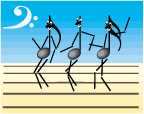
This table lists a variety of songs and a tempo range for each dance.
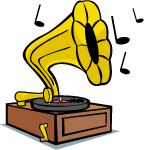 Playing
Audio Files
Playing
Audio FilesThis chapter includes links to brief (30-60 second) RealAudio song samples on the CDNow.com website. To play the samples, the RealAudio player must be installed on your computer. You will also need a session cookie on your computer that is created by opening a CDNow.com window. The CDNow page automatically opened in the lower frame generates this cookie, and provides instructions for installing RealAudio. In other words, once the RealAudio player is installed, you should be able to use the audio clip links automatically.
Note: if the RealAudio player reports that it can not find a sound file, it's likely that the server for that file is temporarily down.
This chapter has neglected numerous partner dances that I either do not know or do not often use, including Merengue, Polka, Paso Doble, Push, Whip, Milonga, vintage dances, Country/Western dances, etc. However, these may be good additions to your dance repertoire!
Copyright 2000 by Ronnen Levinson. All rights reserved.